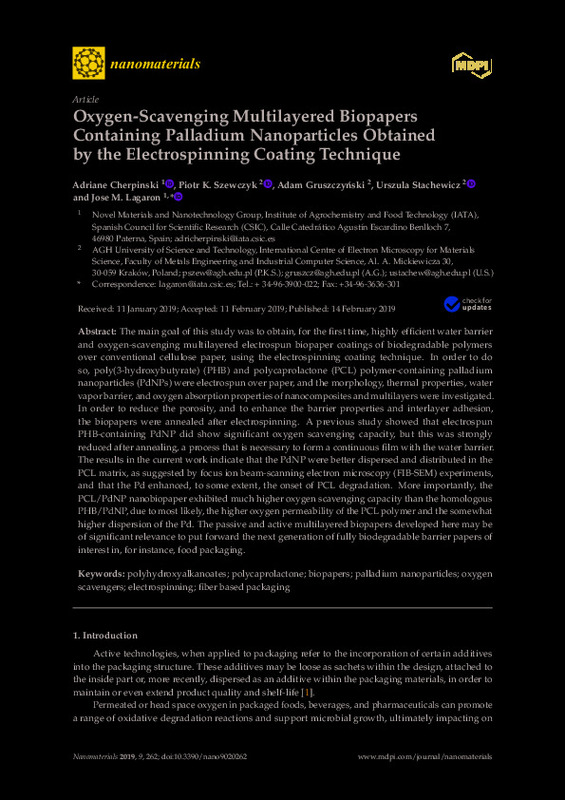JavaScript is disabled for your browser. Some features of this site may not work without it.
Buscar en RiuNet
Listar
Mi cuenta
Estadísticas
Ayuda RiuNet
Admin. UPV
Oxygen-Scavenging Multilayered Biopapers Containing Palladium Nanoparticles Obtained by the Electrospinning Coating Technique
Mostrar el registro sencillo del ítem
Ficheros en el ítem
| dc.contributor.author | Cherpinski, Adriane
|
es_ES |
| dc.contributor.author | Szewczyk, Piotr K.
|
es_ES |
| dc.contributor.author | Gruszczynski, Adam
|
es_ES |
| dc.contributor.author | Stachewicz, Urszula
|
es_ES |
| dc.contributor.author | Lagaron, Jose M.
|
es_ES |
| dc.date.accessioned | 2024-02-29T19:02:43Z | |
| dc.date.available | 2024-02-29T19:02:43Z | |
| dc.date.issued | 2019-02 | es_ES |
| dc.identifier.uri | http://hdl.handle.net/10251/202848 | |
| dc.description.abstract | [EN] The main goal of this study was to obtain, for the first time, highly efficient water barrier and oxygen-scavenging multilayered electrospun biopaper coatings of biodegradable polymers over conventional cellulose paper, using the electrospinning coating technique. In order to do so, poly(3-hydroxybutyrate) (PHB) and polycaprolactone (PCL) polymer-containing palladium nanoparticles (PdNPs) were electrospun over paper, and the morphology, thermal properties, water vapor barrier, and oxygen absorption properties of nanocomposites and multilayers were investigated. In order to reduce the porosity, and to enhance the barrier properties and interlayer adhesion, the biopapers were annealed after electrospinning. A previous study showed that electrospun PHB-containing PdNP did show significant oxygen scavenging capacity, but this was strongly reduced after annealing, a process that is necessary to form a continuous film with the water barrier. The results in the current work indicate that the PdNP were better dispersed and distributed in the PCL matrix, as suggested by focus ion beam-scanning electron microscopy (FIB-SEM) experiments, and that the Pd enhanced, to some extent, the onset of PCL degradation. More importantly, the PCL/PdNP nanobiopaper exhibited much higher oxygen scavenging capacity than the homologous PHB/PdNP, due to most likely, the higher oxygen permeability of the PCL polymer and the somewhat higher dispersion of the Pd. The passive and active multilayered biopapers developed here may be of significant relevance to put forward the next generation of fully biodegradable barrier papers of interest in, for instance, food packaging. | es_ES |
| dc.description.sponsorship | This research was funded by the Spanish Ministry of Economy and Competitiveness (MINECO) project AGL2015-63855-C2-1-R, the H2020 EU YPACK (reference number 773872) and ResUrbis (Reference number 730349). A. Cherpinski would like to thank the Brazilian Council for Scientific and Technological Development (CNPq) of the Brazilian Government for her predoctoral grant (205955/2014-2). U. Stachewicz thanks the National Science Centre in Poland for the Sonata Bis 5 project, No 2015/18/E/ST5/00230 allowing this study, and a PhD scholarship for P.K. Szewczyk. | es_ES |
| dc.language | Inglés | es_ES |
| dc.publisher | MDPI AG | es_ES |
| dc.relation.ispartof | Nanomaterials | es_ES |
| dc.rights | Reconocimiento (by) | es_ES |
| dc.subject | Polyhydroxyalkanoates | es_ES |
| dc.subject | Polycaprolactone | es_ES |
| dc.subject | Biopapers | es_ES |
| dc.subject | Palladium nanoparticles | es_ES |
| dc.subject | Oxygen scavengers | es_ES |
| dc.subject | Electrospinning | es_ES |
| dc.subject | Fiber based packaging | es_ES |
| dc.title | Oxygen-Scavenging Multilayered Biopapers Containing Palladium Nanoparticles Obtained by the Electrospinning Coating Technique | es_ES |
| dc.type | Artículo | es_ES |
| dc.identifier.doi | 10.3390/nano9020262 | es_ES |
| dc.relation.projectID | info:eu-repo/grantAgreement/EC/H2020/730349/EU | es_ES |
| dc.relation.projectID | info:eu-repo/grantAgreement/EC/H2020/773872/EU | es_ES |
| dc.relation.projectID | info:eu-repo/grantAgreement/MINECO//AGL2015-63855-C2-1-R/ES/DESARROLLO DE UN CONCEPTO DE ENVASE MULTICAPA ALIMENTARIO DE ALTA BARRERA Y CON CARACTER ACTIVO Y BIOACTIVO DERIVADO DE SUBPRODUCTOS ALIMENTARIOS/ | es_ES |
| dc.relation.projectID | info:eu-repo/grantAgreement/CNPq//205955%2F2014-2/ | es_ES |
| dc.relation.projectID | info:eu-repo/grantAgreement/NCN//2015%2F18%2FE%2FST5%2F00230/ | es_ES |
| dc.rights.accessRights | Abierto | es_ES |
| dc.description.bibliographicCitation | Cherpinski, A.; Szewczyk, PK.; Gruszczynski, A.; Stachewicz, U.; Lagaron, JM. (2019). Oxygen-Scavenging Multilayered Biopapers Containing Palladium Nanoparticles Obtained by the Electrospinning Coating Technique. Nanomaterials. 9(2). https://doi.org/10.3390/nano9020262 | es_ES |
| dc.description.accrualMethod | S | es_ES |
| dc.relation.publisherversion | https://doi.org/10.3390/nano9020262 | es_ES |
| dc.type.version | info:eu-repo/semantics/publishedVersion | es_ES |
| dc.description.volume | 9 | es_ES |
| dc.description.issue | 2 | es_ES |
| dc.identifier.eissn | 2079-4991 | es_ES |
| dc.identifier.pmid | 30769855 | es_ES |
| dc.identifier.pmcid | PMC6409785 | es_ES |
| dc.relation.pasarela | S\378392 | es_ES |
| dc.contributor.funder | European Commission | es_ES |
| dc.contributor.funder | National Science Centre, Polonia | es_ES |
| dc.contributor.funder | Ministerio de Economía y Competitividad | es_ES |
| dc.contributor.funder | Conselho Nacional de Desenvolvimento Científico e Tecnológico, Brasil | es_ES |








